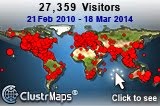Being that I have just spent the last two days at the North American Jewish Day School Conference and am in the process of co-organizing the upcoming edJEWcon conference, I've been thinking quite a bit about the practice of "virtual participation" at conferences.
My colleague, Silvia Tolisano, wrote this post, outlining what it takes to make virtual participation work. Since that post was published, we have received inquiries from people interested in virtual attendance at edJEWcon. We have also been questioned on the decision not to charge for virtual attendance. In the ensuing conversations it has become clear to me that the idea of virtual attendance means different things to different people.
So, one question to be answered is this: what does virtual attendance at a conference look and feel like? Is it qualitatively different than watching a video, participating in a webinar, reading a blog post about a conference or following a conference hashtag on Twitter? If so, how?
As Silvia made clear, there are two distinct parts to making virtual attendance work- part one is the work of the virtual participant; part two relies on the face-to-face attendee. Both must make a commitment to connect. We decided to practice this skill while I was at NAJDS. We would use our regularly-scheduled Monday meeting times with teachers to demonstrate by doing. Silvia also scheduled time with the middle school students, inviting them to participate in a Today's Meet backchannel of the Monday session with Dr. Heidi Hayes Jacobs.
 |
| Image Credit: Silvia Tolisano http://twitpic.com/c0vdzr |
Today's Meet is simple to use. A "room" is created generating a unique URL, which is then shared. Type your name, and you're in. We also Skyped so that the students in FL could hear the same thing that the in-room participants in DC were hearing. Our middle school students are experienced back-channelers.
Here are a few screenshots taken from the transcript of the back channel (which is many pages long). As you look at them, try to get a feel for the conversation. Can you tell if there was a meaningful conversation in response to what was happening at the conference? Were people engaged with one another in the back channel?
 | ||
Starting out with greetings
At some point, the students left to go to other classes. We turned off Skype and I turned to Twitter to continue sharing my notes.
Later in the day, I connected again with Silvia who had reviewed the Today's Meet and the hashtag tweets with some teachers at an afternoon meeting. She was disappointed at the lack of substantial tweets and didn't feel that she was able to connect with what was happening at the conference.
What went wrong? As I reflected, I realized that I got involved in something that, for many people, represents the most valued part of going to a conference- face to face conversations. I had the amazing opportunity to chat with Heidi Hayes Jacobs. No way was I going to dilute the energy of that experience by taking out my phone and tweeting our conversation. So, to my partner back at school, I had abandoned my responsibility by going off the grid.
I thought about Silvia's experience with the lack of meaningful tweets in relation to what I had noticed in the morning session. Almost everyone in that session was taking notes. What I noticed was that most people were taking notes in “closed” apps or on paper. What I mean by closed apps are applications, like MS Word, that are visible only to the one taking the notes. This is not to make the assumption that people don’t share those notes in some way or another. I don't know how, when or with whom those notes might be shared.
Live Blogging
Later in the afternoon, I attended an interesting and very conversational session titled “Moving From Authenticity to Integrity: A Conversation About Jewish Practice in Jewish Day Schools.” With Silvia’s comment about "empty shells" fresh in my mind, I wondered how best to share the conversation in the room. I decided to “live blog” on our school’s closed faculty Ning since the topic has a rather specific audience. The post was not processed nor polished; I simply shared my notes. This was the type of session in which I probably would not have taken notes if not for the fact that I was consciously trying to share my conference experience. It was very conversational, and I typically prefer to focus my attention on the conversation as opposed to trying to transcribe it. Nevertheless, I transcribed and published.
Forty-eight hours later that post has received no comments. I do not know if it has impacted or interested anyone back at my school. Was it a valuable use of my time? Will I be happy, in later days, to have those notes available as I reflect and process my learning? Will those notes eventually lead to anything- a conversation, a blog post, a connection?
What Makes Sense?
I admit that I am skeptical (which, if you know me, is nothing new) about this whole idea of virtual conference attendance. In picking it apart, from both sides of the table, I feel that there are very directed ways of making this work, but that there are certain benefits of conference attendance that can not be replicated. That is not to say that we should not share what we are hearing, both for ourselves and others, nor that we should not consciously wrestle with how best to facilitate meaningful connections.
In trying to understand and contribute to an idea of "best practices" for both in-person and virtual conference attendees, I think it is important to collect data. I am working on a survey, which I will share soon. If you are interested in participating in the survey, please let me know. If you have an opinion, experience, questions or other thoughts, please share in the comments!
|






